Evaluating Care & Support for Specific Needs in Health Services
VerifiedAdded on 2024/05/21
|21
|5433
|395
Report
AI Summary
This report provides a comprehensive analysis of specific needs within health and social care services, focusing on the case of Mr. HL, a dementia patient. It examines the concepts of behavior, health, illness, and disability, assessing how perceptions of specific needs have evolved over time. The report analyzes the impact of legislation, social policy, society, and culture on care provisions. It delves into Mr. HL's specific care needs, evaluates current support systems and available services, and explains various approaches and interventions. Furthermore, the effectiveness of intervention strategies is evaluated, and the potential impact of emerging developments on support for individuals like Mr. HL is discussed. The report also addresses challenging behaviors associated with specific needs, their impact on healthcare organizations, and strategies for managing them, ultimately aiming to provide insights for improving care and support for individuals with dementia and similar conditions.
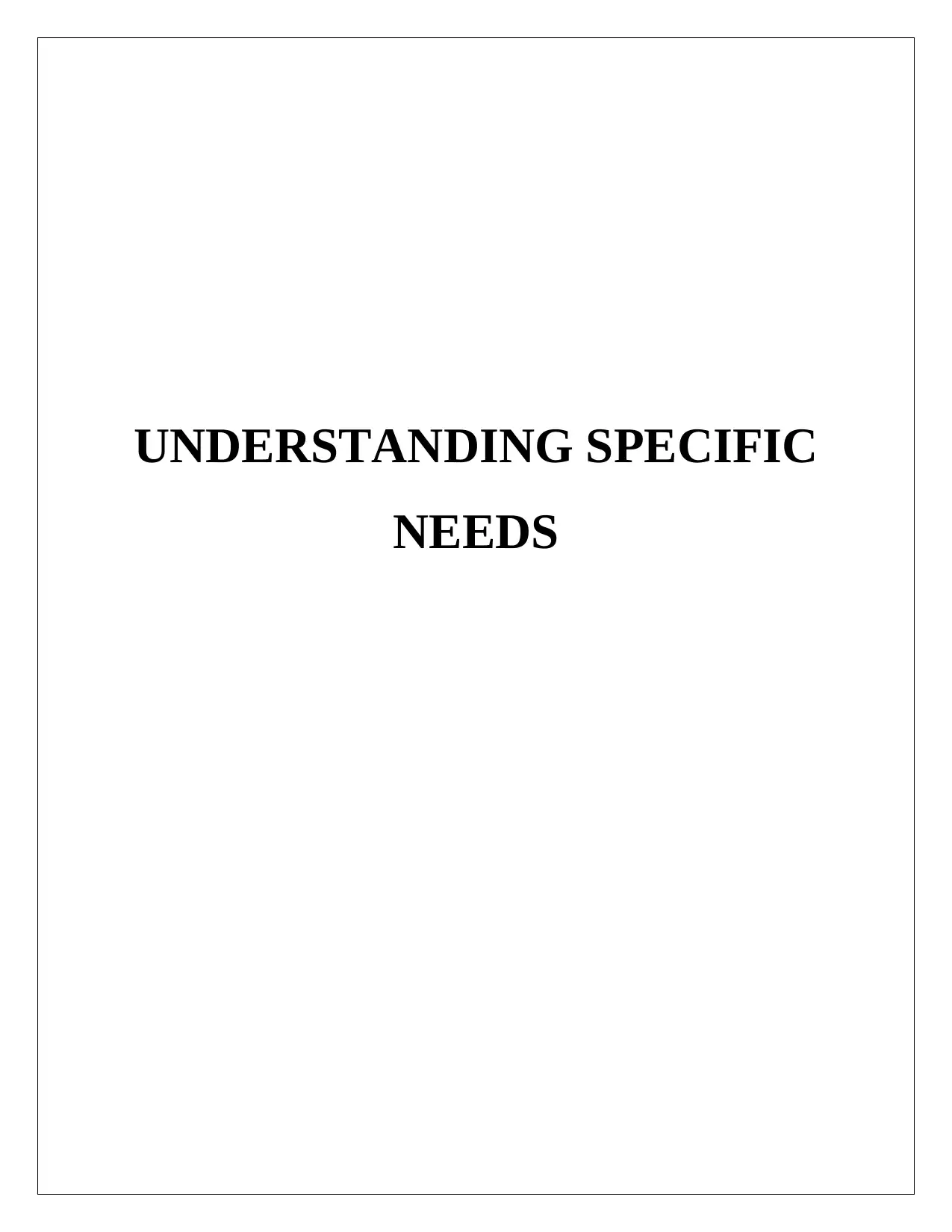
UNDERSTANDING SPECIFIC
NEEDS
NEEDS
Paraphrase This Document
Need a fresh take? Get an instant paraphrase of this document with our AI Paraphraser

Table of Contents
Introduction......................................................................................................................................1
Task 1...............................................................................................................................................2
AC 1.1 In relation to the people who use health and social care services analyze the concepts
of behavior, health, illness and disability (M3)...........................................................................2
AC 1.2 Assess how perceptions of specific needs have changed over time................................3
AC 1.3 Analyze the impact of legislation, social policy, society and culture (D3).....................4
Task 2...............................................................................................................................................5
AC 2.1 Analyze the care needs of Mr. HL with specific needs (M1).........................................5
AC 2.2 Explain current systems for supporting Mr HL with specific needs (D3)......................7
AC 2.3 Evaluate the services available in a chosen locality for Mr HL with specific needs (D1)
.....................................................................................................................................................8
Task 3...............................................................................................................................................9
AC 3.1 Explain the approaches and interventions available to support Mr HL with specific
needs............................................................................................................................................9
AC 3.2 Evaluate the effectiveness of intervention strategies....................................................11
AC 3.3 Discuss the potential impact of emerging developments on support of Mr HL...........12
Task 4.............................................................................................................................................13
AC 4.1 explain different concepts of challenging behaviour based on Mr HL case study.......13
AC 4.2 Describe the potential impact of challenging behaviour on health and social care
organisations..............................................................................................................................14
AC 4.3 Analyse strategies for working with challenging behaviours associated with specific
needs..........................................................................................................................................15
Conclusion.....................................................................................................................................16
References......................................................................................................................................17
Introduction......................................................................................................................................1
Task 1...............................................................................................................................................2
AC 1.1 In relation to the people who use health and social care services analyze the concepts
of behavior, health, illness and disability (M3)...........................................................................2
AC 1.2 Assess how perceptions of specific needs have changed over time................................3
AC 1.3 Analyze the impact of legislation, social policy, society and culture (D3).....................4
Task 2...............................................................................................................................................5
AC 2.1 Analyze the care needs of Mr. HL with specific needs (M1).........................................5
AC 2.2 Explain current systems for supporting Mr HL with specific needs (D3)......................7
AC 2.3 Evaluate the services available in a chosen locality for Mr HL with specific needs (D1)
.....................................................................................................................................................8
Task 3...............................................................................................................................................9
AC 3.1 Explain the approaches and interventions available to support Mr HL with specific
needs............................................................................................................................................9
AC 3.2 Evaluate the effectiveness of intervention strategies....................................................11
AC 3.3 Discuss the potential impact of emerging developments on support of Mr HL...........12
Task 4.............................................................................................................................................13
AC 4.1 explain different concepts of challenging behaviour based on Mr HL case study.......13
AC 4.2 Describe the potential impact of challenging behaviour on health and social care
organisations..............................................................................................................................14
AC 4.3 Analyse strategies for working with challenging behaviours associated with specific
needs..........................................................................................................................................15
Conclusion.....................................................................................................................................16
References......................................................................................................................................17

⊘ This is a preview!⊘
Do you want full access?
Subscribe today to unlock all pages.

Trusted by 1+ million students worldwide
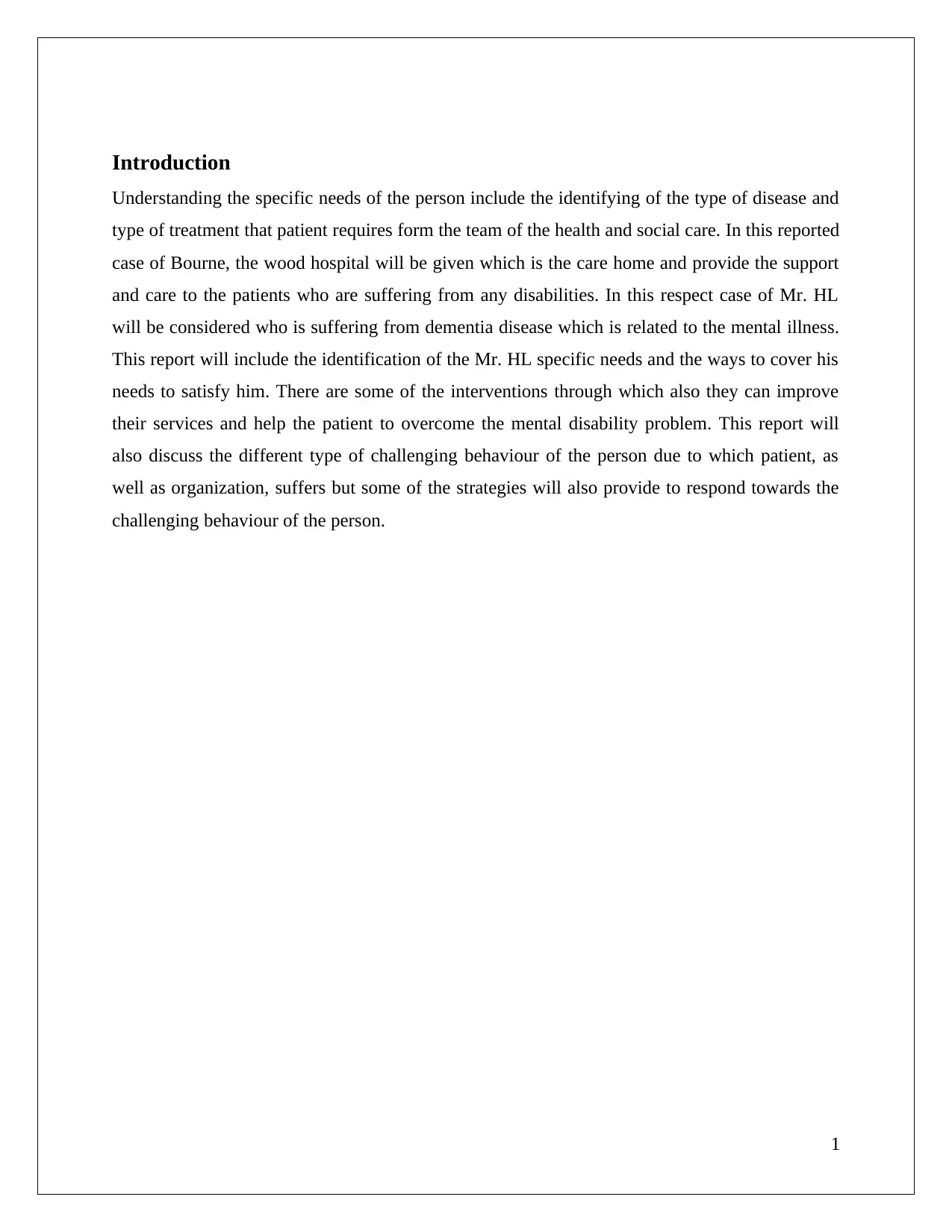
Introduction
Understanding the specific needs of the person include the identifying of the type of disease and
type of treatment that patient requires form the team of the health and social care. In this reported
case of Bourne, the wood hospital will be given which is the care home and provide the support
and care to the patients who are suffering from any disabilities. In this respect case of Mr. HL
will be considered who is suffering from dementia disease which is related to the mental illness.
This report will include the identification of the Mr. HL specific needs and the ways to cover his
needs to satisfy him. There are some of the interventions through which also they can improve
their services and help the patient to overcome the mental disability problem. This report will
also discuss the different type of challenging behaviour of the person due to which patient, as
well as organization, suffers but some of the strategies will also provide to respond towards the
challenging behaviour of the person.
1
Understanding the specific needs of the person include the identifying of the type of disease and
type of treatment that patient requires form the team of the health and social care. In this reported
case of Bourne, the wood hospital will be given which is the care home and provide the support
and care to the patients who are suffering from any disabilities. In this respect case of Mr. HL
will be considered who is suffering from dementia disease which is related to the mental illness.
This report will include the identification of the Mr. HL specific needs and the ways to cover his
needs to satisfy him. There are some of the interventions through which also they can improve
their services and help the patient to overcome the mental disability problem. This report will
also discuss the different type of challenging behaviour of the person due to which patient, as
well as organization, suffers but some of the strategies will also provide to respond towards the
challenging behaviour of the person.
1
Paraphrase This Document
Need a fresh take? Get an instant paraphrase of this document with our AI Paraphraser
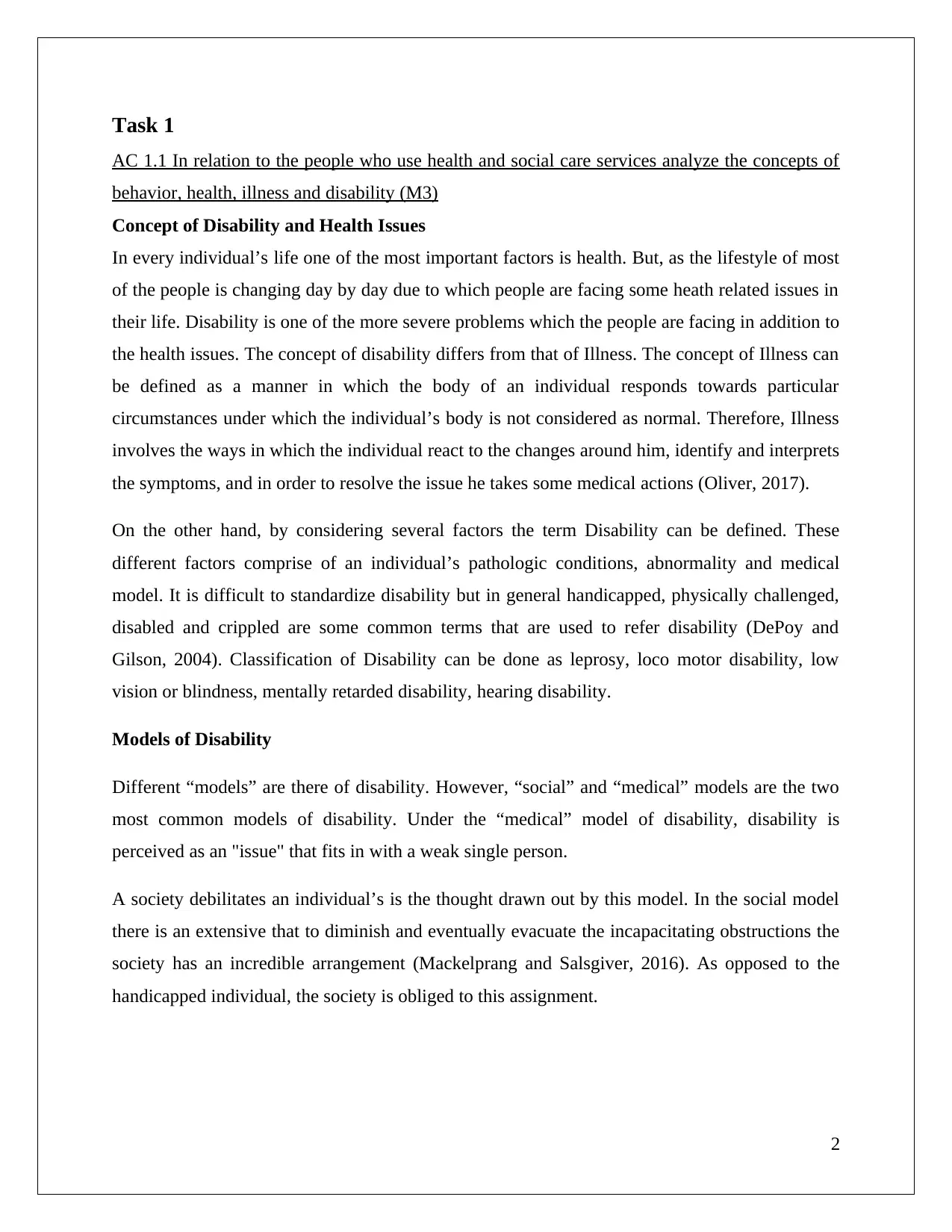
Task 1
AC 1.1 In relation to the people who use health and social care services analyze the concepts of
behavior, health, illness and disability (M3)
Concept of Disability and Health Issues
In every individual’s life one of the most important factors is health. But, as the lifestyle of most
of the people is changing day by day due to which people are facing some heath related issues in
their life. Disability is one of the more severe problems which the people are facing in addition to
the health issues. The concept of disability differs from that of Illness. The concept of Illness can
be defined as a manner in which the body of an individual responds towards particular
circumstances under which the individual’s body is not considered as normal. Therefore, Illness
involves the ways in which the individual react to the changes around him, identify and interprets
the symptoms, and in order to resolve the issue he takes some medical actions (Oliver, 2017).
On the other hand, by considering several factors the term Disability can be defined. These
different factors comprise of an individual’s pathologic conditions, abnormality and medical
model. It is difficult to standardize disability but in general handicapped, physically challenged,
disabled and crippled are some common terms that are used to refer disability (DePoy and
Gilson, 2004). Classification of Disability can be done as leprosy, loco motor disability, low
vision or blindness, mentally retarded disability, hearing disability.
Models of Disability
Different “models” are there of disability. However, “social” and “medical” models are the two
most common models of disability. Under the “medical” model of disability, disability is
perceived as an "issue" that fits in with a weak single person.
A society debilitates an individual’s is the thought drawn out by this model. In the social model
there is an extensive that to diminish and eventually evacuate the incapacitating obstructions the
society has an incredible arrangement (Mackelprang and Salsgiver, 2016). As opposed to the
handicapped individual, the society is obliged to this assignment.
2
AC 1.1 In relation to the people who use health and social care services analyze the concepts of
behavior, health, illness and disability (M3)
Concept of Disability and Health Issues
In every individual’s life one of the most important factors is health. But, as the lifestyle of most
of the people is changing day by day due to which people are facing some heath related issues in
their life. Disability is one of the more severe problems which the people are facing in addition to
the health issues. The concept of disability differs from that of Illness. The concept of Illness can
be defined as a manner in which the body of an individual responds towards particular
circumstances under which the individual’s body is not considered as normal. Therefore, Illness
involves the ways in which the individual react to the changes around him, identify and interprets
the symptoms, and in order to resolve the issue he takes some medical actions (Oliver, 2017).
On the other hand, by considering several factors the term Disability can be defined. These
different factors comprise of an individual’s pathologic conditions, abnormality and medical
model. It is difficult to standardize disability but in general handicapped, physically challenged,
disabled and crippled are some common terms that are used to refer disability (DePoy and
Gilson, 2004). Classification of Disability can be done as leprosy, loco motor disability, low
vision or blindness, mentally retarded disability, hearing disability.
Models of Disability
Different “models” are there of disability. However, “social” and “medical” models are the two
most common models of disability. Under the “medical” model of disability, disability is
perceived as an "issue" that fits in with a weak single person.
A society debilitates an individual’s is the thought drawn out by this model. In the social model
there is an extensive that to diminish and eventually evacuate the incapacitating obstructions the
society has an incredible arrangement (Mackelprang and Salsgiver, 2016). As opposed to the
handicapped individual, the society is obliged to this assignment.
2
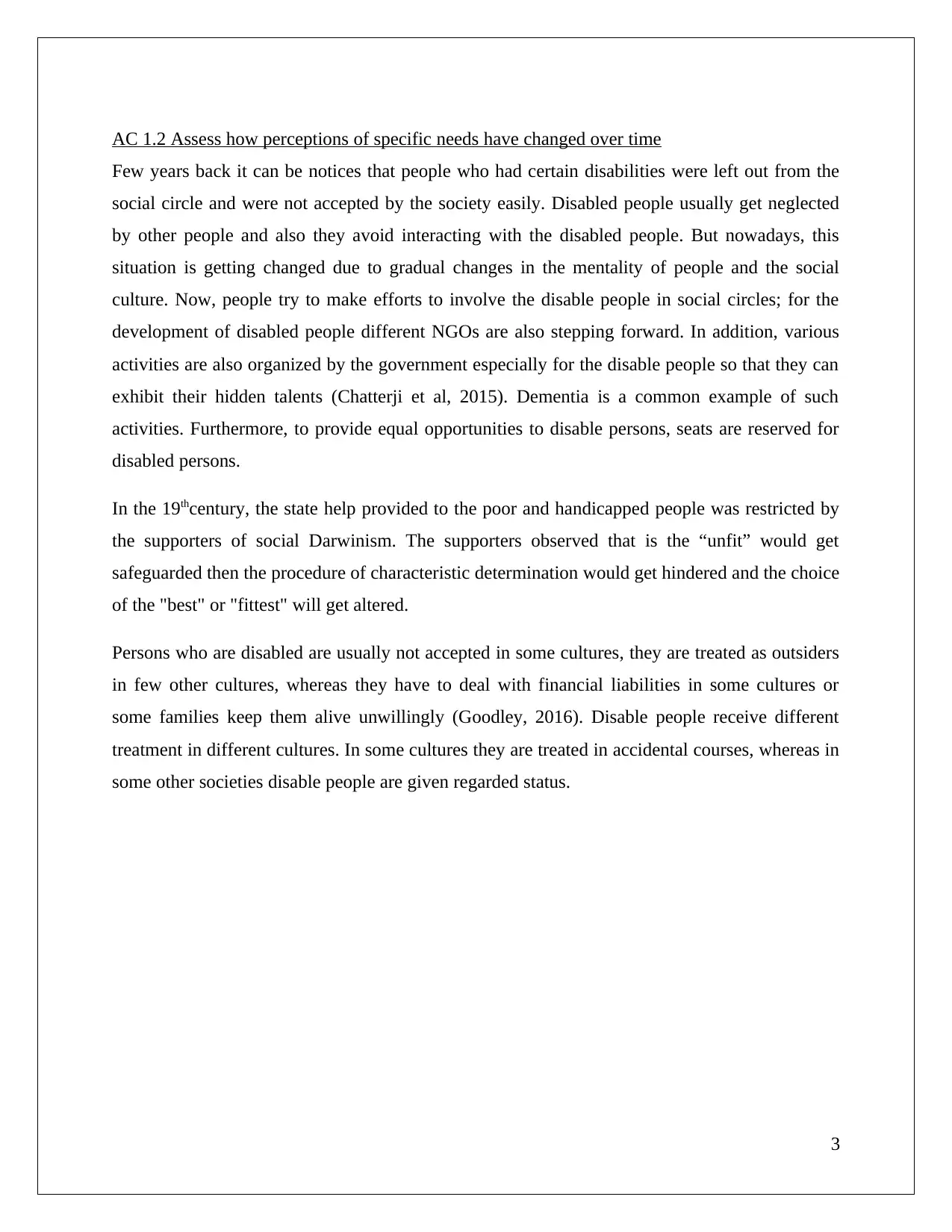
AC 1.2 Assess how perceptions of specific needs have changed over time
Few years back it can be notices that people who had certain disabilities were left out from the
social circle and were not accepted by the society easily. Disabled people usually get neglected
by other people and also they avoid interacting with the disabled people. But nowadays, this
situation is getting changed due to gradual changes in the mentality of people and the social
culture. Now, people try to make efforts to involve the disable people in social circles; for the
development of disabled people different NGOs are also stepping forward. In addition, various
activities are also organized by the government especially for the disable people so that they can
exhibit their hidden talents (Chatterji et al, 2015). Dementia is a common example of such
activities. Furthermore, to provide equal opportunities to disable persons, seats are reserved for
disabled persons.
In the 19thcentury, the state help provided to the poor and handicapped people was restricted by
the supporters of social Darwinism. The supporters observed that is the “unfit” would get
safeguarded then the procedure of characteristic determination would get hindered and the choice
of the "best" or "fittest" will get altered.
Persons who are disabled are usually not accepted in some cultures, they are treated as outsiders
in few other cultures, whereas they have to deal with financial liabilities in some cultures or
some families keep them alive unwillingly (Goodley, 2016). Disable people receive different
treatment in different cultures. In some cultures they are treated in accidental courses, whereas in
some other societies disable people are given regarded status.
3
Few years back it can be notices that people who had certain disabilities were left out from the
social circle and were not accepted by the society easily. Disabled people usually get neglected
by other people and also they avoid interacting with the disabled people. But nowadays, this
situation is getting changed due to gradual changes in the mentality of people and the social
culture. Now, people try to make efforts to involve the disable people in social circles; for the
development of disabled people different NGOs are also stepping forward. In addition, various
activities are also organized by the government especially for the disable people so that they can
exhibit their hidden talents (Chatterji et al, 2015). Dementia is a common example of such
activities. Furthermore, to provide equal opportunities to disable persons, seats are reserved for
disabled persons.
In the 19thcentury, the state help provided to the poor and handicapped people was restricted by
the supporters of social Darwinism. The supporters observed that is the “unfit” would get
safeguarded then the procedure of characteristic determination would get hindered and the choice
of the "best" or "fittest" will get altered.
Persons who are disabled are usually not accepted in some cultures, they are treated as outsiders
in few other cultures, whereas they have to deal with financial liabilities in some cultures or
some families keep them alive unwillingly (Goodley, 2016). Disable people receive different
treatment in different cultures. In some cultures they are treated in accidental courses, whereas in
some other societies disable people are given regarded status.
3
⊘ This is a preview!⊘
Do you want full access?
Subscribe today to unlock all pages.

Trusted by 1+ million students worldwide

AC 1.3 Analyze the impact of legislation, social policy, society and culture (D3)
Disable People are not as much fortune as the people who are fit physically. Therefore, in order
to provide equal opportunities to disable people in different sectors of life, various laws and acts
have been framed by the UK government. Furthermore, in every nation the government has
ensured significant help to disabled people in making their lives convenient by framing certain
laws, rules and legislations (Albrecht, 2005).
The following acts are included in current enactments:
1. Health Act 1999: the providers of social and human resource services have three adaptable
forces incorporated by Health Act 1999: the three forces are-
To pool their funding
To make the combination of service providers
To create the main commission courses of action (Stock, 2017).
2. Care Trust: It has the responsibility to look after the care activities and has 10 organizations.
3. Children’s Trust: It is responsible for working and sharing the information with youth and
also conducts the surveys to identify the basic needs for youth care.
4. Personal Health Budgets: fundamentally this is implied for the beforehand thoughts of
adults. This strategy allows the patients to get money in return of the services they have availed
from the providers of health care. The poor or disabled people can get great health offices
through this coordination (Shaw and Middleton, 2016).
4
Disable People are not as much fortune as the people who are fit physically. Therefore, in order
to provide equal opportunities to disable people in different sectors of life, various laws and acts
have been framed by the UK government. Furthermore, in every nation the government has
ensured significant help to disabled people in making their lives convenient by framing certain
laws, rules and legislations (Albrecht, 2005).
The following acts are included in current enactments:
1. Health Act 1999: the providers of social and human resource services have three adaptable
forces incorporated by Health Act 1999: the three forces are-
To pool their funding
To make the combination of service providers
To create the main commission courses of action (Stock, 2017).
2. Care Trust: It has the responsibility to look after the care activities and has 10 organizations.
3. Children’s Trust: It is responsible for working and sharing the information with youth and
also conducts the surveys to identify the basic needs for youth care.
4. Personal Health Budgets: fundamentally this is implied for the beforehand thoughts of
adults. This strategy allows the patients to get money in return of the services they have availed
from the providers of health care. The poor or disabled people can get great health offices
through this coordination (Shaw and Middleton, 2016).
4
Paraphrase This Document
Need a fresh take? Get an instant paraphrase of this document with our AI Paraphraser
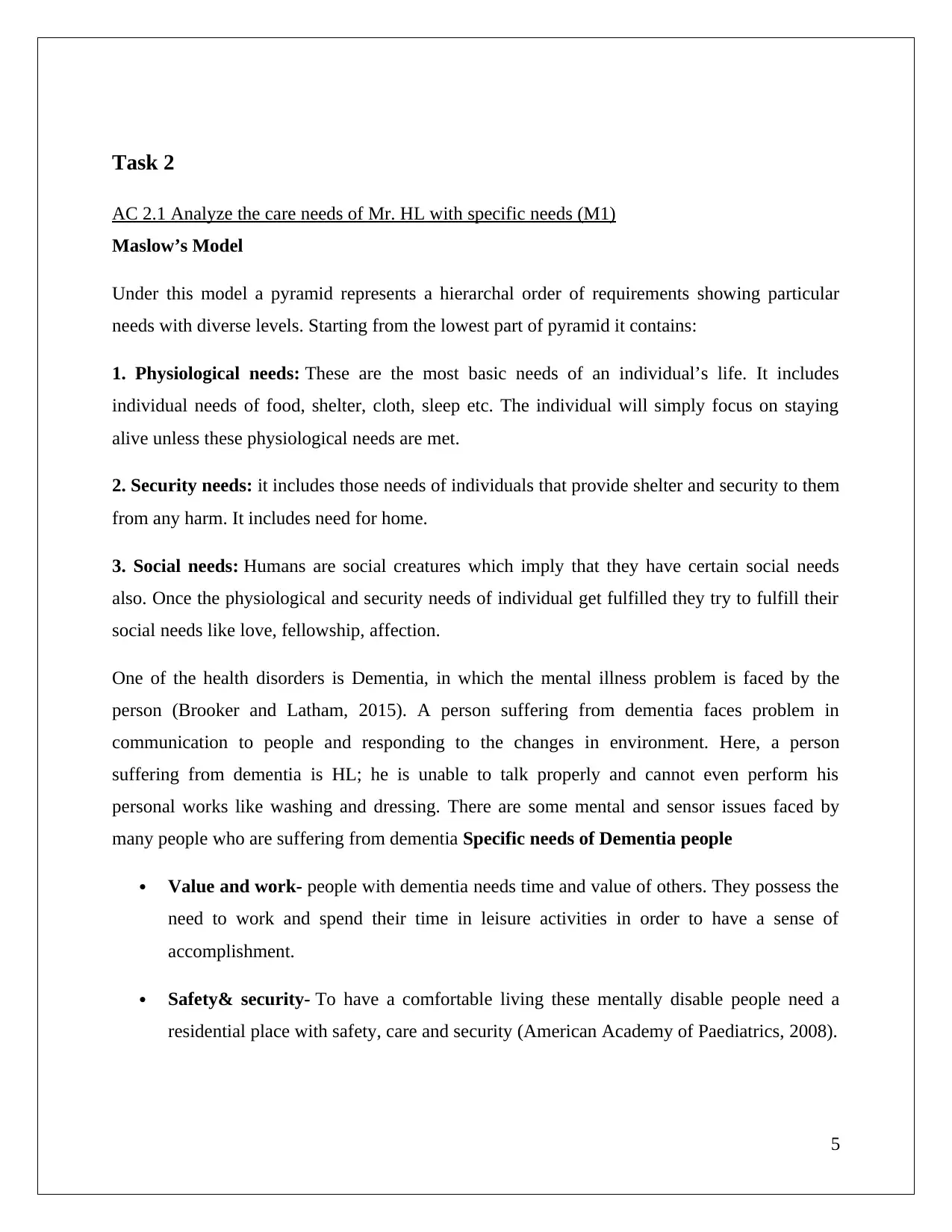
Task 2
AC 2.1 Analyze the care needs of Mr. HL with specific needs (M1)
Maslow’s Model
Under this model a pyramid represents a hierarchal order of requirements showing particular
needs with diverse levels. Starting from the lowest part of pyramid it contains:
1. Physiological needs: These are the most basic needs of an individual’s life. It includes
individual needs of food, shelter, cloth, sleep etc. The individual will simply focus on staying
alive unless these physiological needs are met.
2. Security needs: it includes those needs of individuals that provide shelter and security to them
from any harm. It includes need for home.
3. Social needs: Humans are social creatures which imply that they have certain social needs
also. Once the physiological and security needs of individual get fulfilled they try to fulfill their
social needs like love, fellowship, affection.
One of the health disorders is Dementia, in which the mental illness problem is faced by the
person (Brooker and Latham, 2015). A person suffering from dementia faces problem in
communication to people and responding to the changes in environment. Here, a person
suffering from dementia is HL; he is unable to talk properly and cannot even perform his
personal works like washing and dressing. There are some mental and sensor issues faced by
many people who are suffering from dementia Specific needs of Dementia people
Value and work- people with dementia needs time and value of others. They possess the
need to work and spend their time in leisure activities in order to have a sense of
accomplishment.
Safety& security- To have a comfortable living these mentally disable people need a
residential place with safety, care and security (American Academy of Paediatrics, 2008).
5
AC 2.1 Analyze the care needs of Mr. HL with specific needs (M1)
Maslow’s Model
Under this model a pyramid represents a hierarchal order of requirements showing particular
needs with diverse levels. Starting from the lowest part of pyramid it contains:
1. Physiological needs: These are the most basic needs of an individual’s life. It includes
individual needs of food, shelter, cloth, sleep etc. The individual will simply focus on staying
alive unless these physiological needs are met.
2. Security needs: it includes those needs of individuals that provide shelter and security to them
from any harm. It includes need for home.
3. Social needs: Humans are social creatures which imply that they have certain social needs
also. Once the physiological and security needs of individual get fulfilled they try to fulfill their
social needs like love, fellowship, affection.
One of the health disorders is Dementia, in which the mental illness problem is faced by the
person (Brooker and Latham, 2015). A person suffering from dementia faces problem in
communication to people and responding to the changes in environment. Here, a person
suffering from dementia is HL; he is unable to talk properly and cannot even perform his
personal works like washing and dressing. There are some mental and sensor issues faced by
many people who are suffering from dementia Specific needs of Dementia people
Value and work- people with dementia needs time and value of others. They possess the
need to work and spend their time in leisure activities in order to have a sense of
accomplishment.
Safety& security- To have a comfortable living these mentally disable people need a
residential place with safety, care and security (American Academy of Paediatrics, 2008).
5
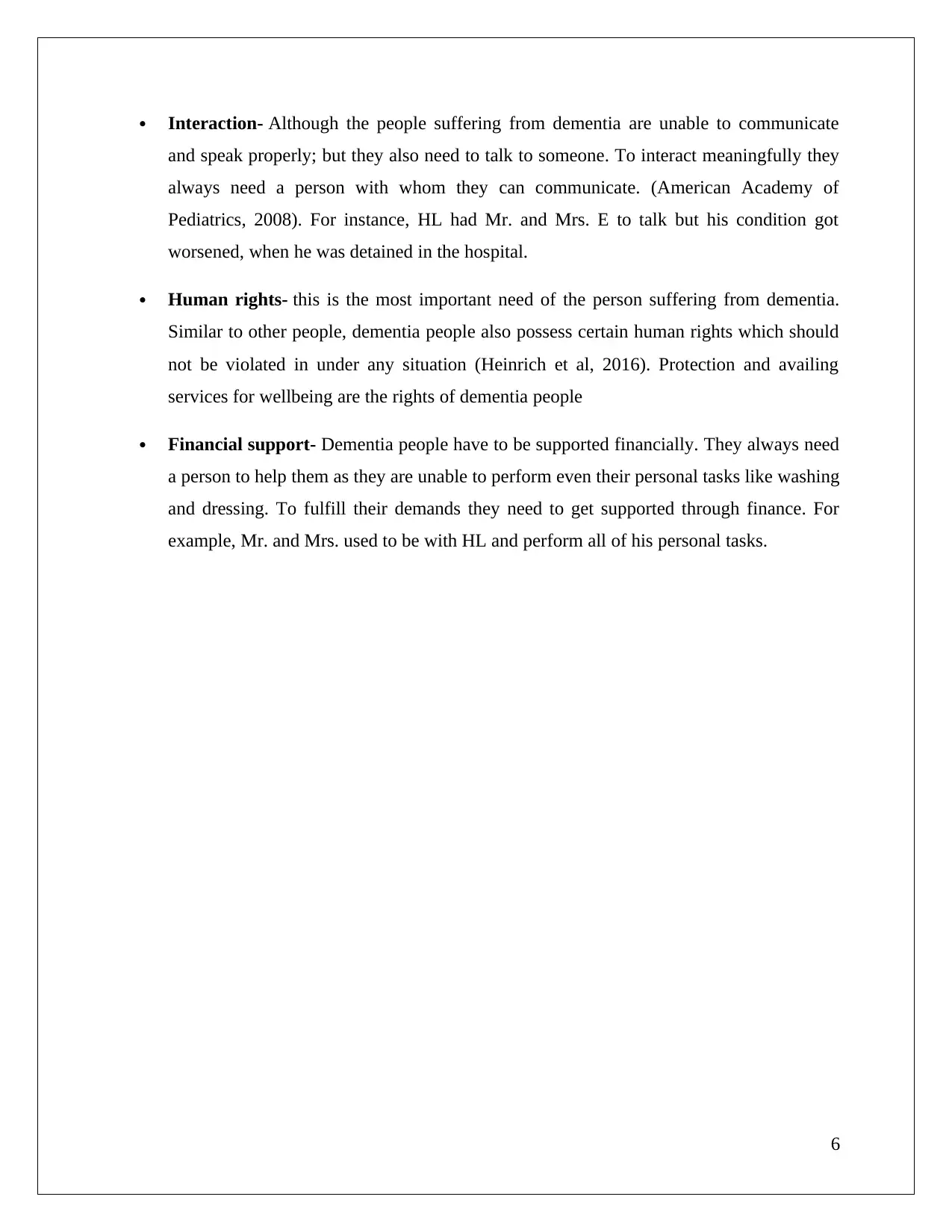
Interaction- Although the people suffering from dementia are unable to communicate
and speak properly; but they also need to talk to someone. To interact meaningfully they
always need a person with whom they can communicate. (American Academy of
Pediatrics, 2008). For instance, HL had Mr. and Mrs. E to talk but his condition got
worsened, when he was detained in the hospital.
Human rights- this is the most important need of the person suffering from dementia.
Similar to other people, dementia people also possess certain human rights which should
not be violated in under any situation (Heinrich et al, 2016). Protection and availing
services for wellbeing are the rights of dementia people
Financial support- Dementia people have to be supported financially. They always need
a person to help them as they are unable to perform even their personal tasks like washing
and dressing. To fulfill their demands they need to get supported through finance. For
example, Mr. and Mrs. used to be with HL and perform all of his personal tasks.
6
and speak properly; but they also need to talk to someone. To interact meaningfully they
always need a person with whom they can communicate. (American Academy of
Pediatrics, 2008). For instance, HL had Mr. and Mrs. E to talk but his condition got
worsened, when he was detained in the hospital.
Human rights- this is the most important need of the person suffering from dementia.
Similar to other people, dementia people also possess certain human rights which should
not be violated in under any situation (Heinrich et al, 2016). Protection and availing
services for wellbeing are the rights of dementia people
Financial support- Dementia people have to be supported financially. They always need
a person to help them as they are unable to perform even their personal tasks like washing
and dressing. To fulfill their demands they need to get supported through finance. For
example, Mr. and Mrs. used to be with HL and perform all of his personal tasks.
6
⊘ This is a preview!⊘
Do you want full access?
Subscribe today to unlock all pages.

Trusted by 1+ million students worldwide

AC 2.2 Explain current systems for supporting Mr HL with specific needs (D3)
Mr. HL is suffering from a mental disability which is known as Dementia disease in which
patient faces issues like- mental illness, insanity, madness or memory loss. It is important for the
patient to get the proper support from the health and social care or care home institutions. There
are various types of the community which provide services to the patients who are suffering from
dementia problem. Mr. HL admitted in Bourne wood hospital for his treatment from the home of
Mr. and Mrs. E. Specific needs to be required by the Mr. HL has been mentioned and discussed
as above but it is also essential for the service provider that they should follow systems for
supporting the specific needs of Mr. HL (Boots et al, 2015). For supporting the specific needs of
Mr. HL, Bourne wood hospital need to appoint well skilled and experienced employees who can
provide full support to the patient who is facing problems because of their mental disability.
They should also organize some of the supporting programs and well-structured events in which
they should provide full training and understanding to their staff members about how they should
treat their patients and how they need to behave with them. This type of programs and training
provided to the staff members will enhance the services and cover the specific needs of the
patients. Patient suffering from this mental issue need mental as well physical support and that
need to be provided by the staff members of Bourne wood hospital. A team of Bourne wood
hospital needs to have experts who can understand the situation, condition, requirement, and
problems of the patient because Mr (Millenaar et al, 2016). HL cannot speak or move from his
place. The hospital must also implement the policies in respect of the Mental Health Act in
which team should follow that Act in respect of the dementia patients.
7
Mr. HL is suffering from a mental disability which is known as Dementia disease in which
patient faces issues like- mental illness, insanity, madness or memory loss. It is important for the
patient to get the proper support from the health and social care or care home institutions. There
are various types of the community which provide services to the patients who are suffering from
dementia problem. Mr. HL admitted in Bourne wood hospital for his treatment from the home of
Mr. and Mrs. E. Specific needs to be required by the Mr. HL has been mentioned and discussed
as above but it is also essential for the service provider that they should follow systems for
supporting the specific needs of Mr. HL (Boots et al, 2015). For supporting the specific needs of
Mr. HL, Bourne wood hospital need to appoint well skilled and experienced employees who can
provide full support to the patient who is facing problems because of their mental disability.
They should also organize some of the supporting programs and well-structured events in which
they should provide full training and understanding to their staff members about how they should
treat their patients and how they need to behave with them. This type of programs and training
provided to the staff members will enhance the services and cover the specific needs of the
patients. Patient suffering from this mental issue need mental as well physical support and that
need to be provided by the staff members of Bourne wood hospital. A team of Bourne wood
hospital needs to have experts who can understand the situation, condition, requirement, and
problems of the patient because Mr (Millenaar et al, 2016). HL cannot speak or move from his
place. The hospital must also implement the policies in respect of the Mental Health Act in
which team should follow that Act in respect of the dementia patients.
7
Paraphrase This Document
Need a fresh take? Get an instant paraphrase of this document with our AI Paraphraser
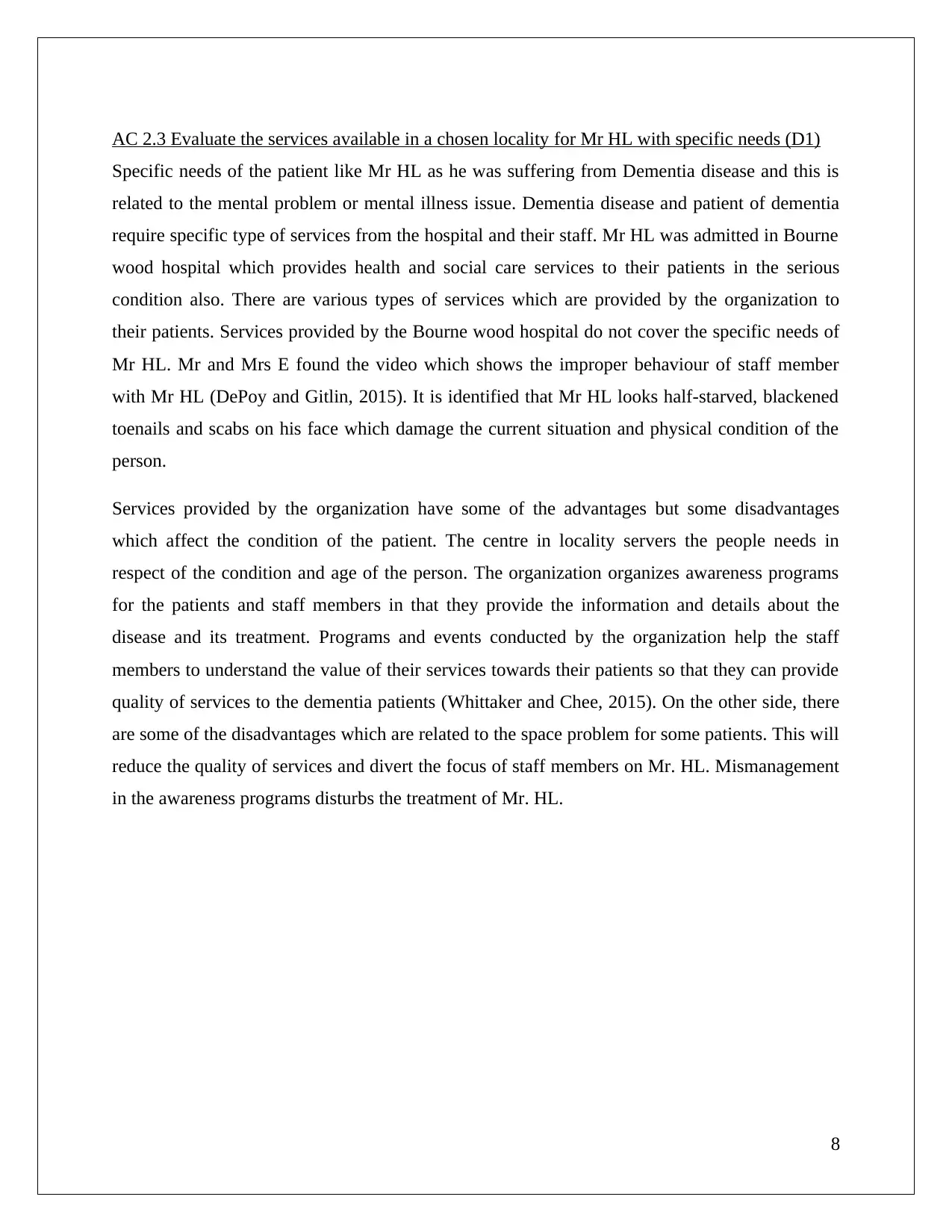
AC 2.3 Evaluate the services available in a chosen locality for Mr HL with specific needs (D1)
Specific needs of the patient like Mr HL as he was suffering from Dementia disease and this is
related to the mental problem or mental illness issue. Dementia disease and patient of dementia
require specific type of services from the hospital and their staff. Mr HL was admitted in Bourne
wood hospital which provides health and social care services to their patients in the serious
condition also. There are various types of services which are provided by the organization to
their patients. Services provided by the Bourne wood hospital do not cover the specific needs of
Mr HL. Mr and Mrs E found the video which shows the improper behaviour of staff member
with Mr HL (DePoy and Gitlin, 2015). It is identified that Mr HL looks half-starved, blackened
toenails and scabs on his face which damage the current situation and physical condition of the
person.
Services provided by the organization have some of the advantages but some disadvantages
which affect the condition of the patient. The centre in locality servers the people needs in
respect of the condition and age of the person. The organization organizes awareness programs
for the patients and staff members in that they provide the information and details about the
disease and its treatment. Programs and events conducted by the organization help the staff
members to understand the value of their services towards their patients so that they can provide
quality of services to the dementia patients (Whittaker and Chee, 2015). On the other side, there
are some of the disadvantages which are related to the space problem for some patients. This will
reduce the quality of services and divert the focus of staff members on Mr. HL. Mismanagement
in the awareness programs disturbs the treatment of Mr. HL.
8
Specific needs of the patient like Mr HL as he was suffering from Dementia disease and this is
related to the mental problem or mental illness issue. Dementia disease and patient of dementia
require specific type of services from the hospital and their staff. Mr HL was admitted in Bourne
wood hospital which provides health and social care services to their patients in the serious
condition also. There are various types of services which are provided by the organization to
their patients. Services provided by the Bourne wood hospital do not cover the specific needs of
Mr HL. Mr and Mrs E found the video which shows the improper behaviour of staff member
with Mr HL (DePoy and Gitlin, 2015). It is identified that Mr HL looks half-starved, blackened
toenails and scabs on his face which damage the current situation and physical condition of the
person.
Services provided by the organization have some of the advantages but some disadvantages
which affect the condition of the patient. The centre in locality servers the people needs in
respect of the condition and age of the person. The organization organizes awareness programs
for the patients and staff members in that they provide the information and details about the
disease and its treatment. Programs and events conducted by the organization help the staff
members to understand the value of their services towards their patients so that they can provide
quality of services to the dementia patients (Whittaker and Chee, 2015). On the other side, there
are some of the disadvantages which are related to the space problem for some patients. This will
reduce the quality of services and divert the focus of staff members on Mr. HL. Mismanagement
in the awareness programs disturbs the treatment of Mr. HL.
8

Task 3
AC 3.1 Explain the approaches and interventions available to support Mr HL with specific needs
There are some patients including Mr. HL who are suffering from disability issue, and the
disease of dementia is increasing at the current time. People who are living in this modern
society are educated and aware of the conditions and its treatment. It becomes very easy for the
person to understand and identify the nature of treatment and the inequality if the organization is
doing with them. Mr. HL is not getting proper service from Bourne wood hospital which makes
the current situation of him more critical, and this is noticed by Mr. and Mrs. E. This type of
identification by Mr. and Mrs. E influence them to fight against the organization in the case of
mental health Act (Czajkowski et al, 2015).
There are various types of approaches and interventions which are required to be followed by the
Bourne wood hospital to support the specific needs of Mr. HL. The worst condition of disabled
people is that another person considers that disabled person poor and only thing on which they
focus is sympathy. For proving these types of illogical assumptions wrong and to spread
awareness about the real condition of the people there are some of the approaches and
interventions developed by the health and social care organizations.
Approaches and Interventions
Physical interventions: This approach is incorporated into the required and suitable activities
and the physical therapies like a meditation of the patient which help Mr. HL to recover from
their mental disability issue (Carpenter et al, 2017). This will help Mr. HL to restore their life
and lost capabilities regarding mobility or any other activity. The major goal of physical
intervention is to move the patient from physical or mental disability to the ordinary or normal
life.
Professional intervention: With the help of this approach they can train their staff members and
workers which will improve their quality of services towards patients like Mr. HL. With the help
of training programs, they can understand the importance of their services for their patients, and
they can procure them for something.
Psychological interventions: It is identified that Mr. HL is suffering from dementia and have a
mental illness, so mental mediation is quite critical for him. With the help of psychological
9
AC 3.1 Explain the approaches and interventions available to support Mr HL with specific needs
There are some patients including Mr. HL who are suffering from disability issue, and the
disease of dementia is increasing at the current time. People who are living in this modern
society are educated and aware of the conditions and its treatment. It becomes very easy for the
person to understand and identify the nature of treatment and the inequality if the organization is
doing with them. Mr. HL is not getting proper service from Bourne wood hospital which makes
the current situation of him more critical, and this is noticed by Mr. and Mrs. E. This type of
identification by Mr. and Mrs. E influence them to fight against the organization in the case of
mental health Act (Czajkowski et al, 2015).
There are various types of approaches and interventions which are required to be followed by the
Bourne wood hospital to support the specific needs of Mr. HL. The worst condition of disabled
people is that another person considers that disabled person poor and only thing on which they
focus is sympathy. For proving these types of illogical assumptions wrong and to spread
awareness about the real condition of the people there are some of the approaches and
interventions developed by the health and social care organizations.
Approaches and Interventions
Physical interventions: This approach is incorporated into the required and suitable activities
and the physical therapies like a meditation of the patient which help Mr. HL to recover from
their mental disability issue (Carpenter et al, 2017). This will help Mr. HL to restore their life
and lost capabilities regarding mobility or any other activity. The major goal of physical
intervention is to move the patient from physical or mental disability to the ordinary or normal
life.
Professional intervention: With the help of this approach they can train their staff members and
workers which will improve their quality of services towards patients like Mr. HL. With the help
of training programs, they can understand the importance of their services for their patients, and
they can procure them for something.
Psychological interventions: It is identified that Mr. HL is suffering from dementia and have a
mental illness, so mental mediation is quite critical for him. With the help of psychological
9
⊘ This is a preview!⊘
Do you want full access?
Subscribe today to unlock all pages.

Trusted by 1+ million students worldwide
1 out of 21
Related Documents
Your All-in-One AI-Powered Toolkit for Academic Success.
+13062052269
info@desklib.com
Available 24*7 on WhatsApp / Email
![[object Object]](/_next/static/media/star-bottom.7253800d.svg)
Unlock your academic potential
Copyright © 2020–2025 A2Z Services. All Rights Reserved. Developed and managed by ZUCOL.




